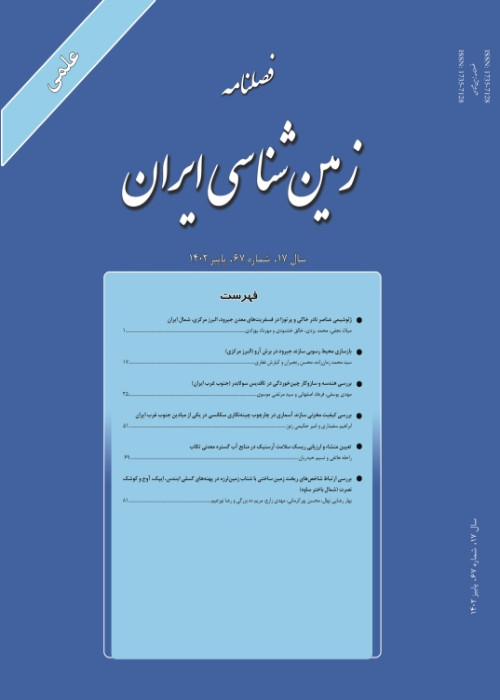Mineralogy, geochemistry, and fluid inclusion characteristics of the Madanjoo skarn iron deposit, Sangan mining district, NE Iran
The Madanjoo prospect is one of the eastern anomalies in the Sangan mining district. This area is located in the eastern part of the Cenozoic Alborz volcanic-plutonic arc. The geology of the area includes Jurassic shaly sandstone, lime mudstone, and sandstone, Upper Cretaceous limestone and dolomitic limestone, and Upper Eocene tuff and lava flow sequences, Middle Eocene skarn rocks, and Quaternary sediments. The most important occurrence in the Madanjoo area is the penetration of ferrous fluids into terrigenous and carbonate formations, skarnization, and iron mineralization, which is characterized by the presence of magnetite and calcsilicates minerals. based on type and frequency of calcsilicates, The skarn zones include olivine-pyroxene-garnet skarn, garnet-pyroxene skarn, garnet skarn, pyroxene-wollastonite-magnetite skarn, magnetite skarn, phlogopite skarn, tremolite-actinolite skarn, and epidote skarn. Iron mineralization occurred as massive, banded, vein-veinlets, breccia, and disseminated forms mostly in the Upper Cretaceous limestone and dolomite rocks and along NE-SW fault zone trend. Magnetite is the main ore mineral accompanied with pyrite, chalcopyrite, pyrrhotite, and secondary iron minerals. The composition of the Madanjoo garnet, pyroxene, and olivine are andradite-grossular (mostly andradite), diopside-hedenbergite (mostly diopside), and forsterite, respectively. Thermobarometry study based on pyroxene chemistry show that pyroxenes crystallized in temperature range of 458-689 °C, pressure of 2.21 kb, and depth range of 1-2.5 km. Three main paragenetic stages of skarn formation and ore deposition were recognized in the Madanjoo deposit: (1) a prograde stage developed with prograde garnet and pyroxene forming at 330° to 410 °C with a fluid salinity between 33 to 58 wt.% NaCl equivalent, (2) a retrograde garnet, tremolite- actinolite, and calcite which formed at 120° to 300 °C with fluid salinity of 16 to 49 wt.% NaCl equivalent, and (3) a post-ore stage with calcite and minor quartz veins that developed at 95° to 190 °C with salinity range of 2 to 15 wt.% NaCl equivalent. Possible iron ore formation mechanisms include: fluid mixing, boiling, and dilution with meteoric waters along with decreasing temperature. Finally, the Madanjoo iron mineralization is introduced as a magnesian exoskarn iron deposit.
- حق عضویت دریافتی صرف حمایت از نشریات عضو و نگهداری، تکمیل و توسعه مگیران میشود.
- پرداخت حق اشتراک و دانلود مقالات اجازه بازنشر آن در سایر رسانههای چاپی و دیجیتال را به کاربر نمیدهد.


